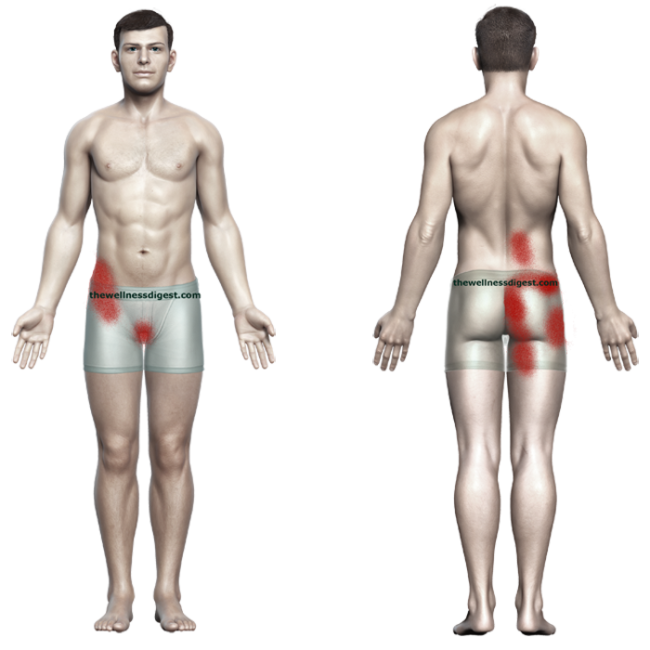
The quadratus lumborum is one of the hardest-working muscles in the body. It connects the hip bone to the lower spine and the lowest rib, stabilizing the lower back and allowing the upper and lower body to move independently.
The muscle is notorious for pain in the lower back, top of the hip, and buttocks. It can also refer pain to the lower abdomen, pelvis, and groin.
QL pain can be sharp and stabbing when moving, coughing, or sneezing. It may also cause a constant deep aching pain that does not let up.
Table of Contents
Where Is The Quadratus Lumborum Muscle?
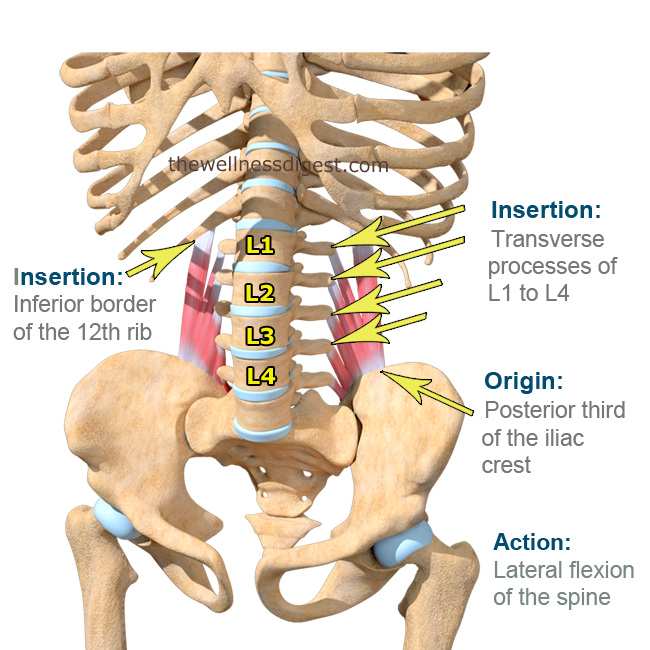
What Does The Quadratus Lumborum Do?
The QL contributes to the following movements:
-
- Side bending at the waist. (lateral flexion)
- Extension of the spine (standing upright)
- Raising the thigh toward the body (flexion of the thigh at the hip)
- Stabilizes the lower back and pelvis
- Assists with breathing out (exhalation)
- Provides support and protection for the internal organs

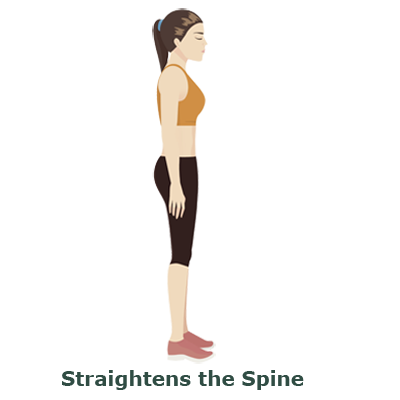
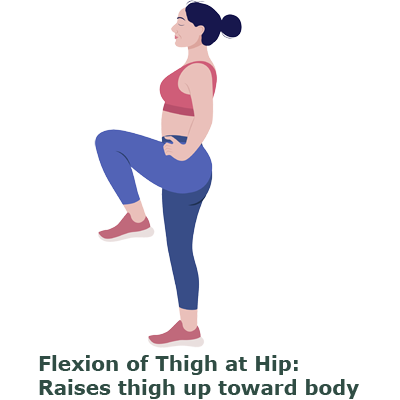
What Are Quadratus Lumborum Pain Symptoms?
Symptoms include:
-
- Deep aching pain in the lower back, even while resting
- Sharp pain in the lower back when moving, coughing, or sneezing
- Stiffness and immobility in the lower back and hip
- Pain in the hips and buttocks
- Groin pain and pelvic pain
- Pain down the front and/or back of the thigh
- Low abdominal pain
- Pain increases when standing, sitting, or lying down for extended amounts of time
QL muscle pain can make your life miserable. The pain is most often felt in the lower back, where the muscle connects to the top of the hip bone and extends toward the middle of the lower back, where the muscle connects to the spine. The pain is often sharp, making you hesitant to move. Moving the leg on the affected side often brings on stabbing pain in the back and around the hip joint.
Another worrying symptom is the referred pain in the front of the body. You may fear a urinary tract infection or kidney stones. Women may think something is happening with the uterus or ovaries. Men may feel pain in the scrotum and testicles. A doctor should check these potential medical conditions. If you get a clean bill of health, then it is time to consider the possibility of QL muscle involvement.
What Causes Quadratus Lumborum Pain?
Two of the main contributors to QL back pain are sleeping on a soft mattress and sitting too much, which puts incredible stress on the QL muscle.
-
- Poor posture - slouching when sitting or standing makes the QL work overtime to stabilize the spine.
- Sleeping on a soft mattress does not support your body weight, stressing the QL muscles.
- Sleeping on your side shortens the muscle on that side and overly elongates the muscle on the opposite side, contributing to pain.
- Lifting heavy objects and twisting while lifting. The QL muscle is engaged each time you lift an object to stabilize and protect the spine. Twisting while lifting throws off the muscles' balance, increasing the chance of strained muscles.
- Activities that require repetitive twisting and turning at the waist and hips.
- Leg length discrepancy: One leg is shorter than the other. You may have been born with a shorter leg, or it can be due to injury. It often occurs after the leg has been in a cast or splint.
- The QL muscles are often affected when you slip and or fall
Sports and activities that affect the quadratus lumborum:
-
- Golf, baseball, softball - repetitive twisting while swinging the club or bat
- Tennis - repetitive side-bending and twisting
- Kayaking and rowing - constant use of the lower back muscles
- Bowling - bending, twisting, and the forward thrust of throwing the ball
- Running - the continuous pounding of the lower body, poor posture, and shallow breathing take a toll on the QL muscle
- Horseback riding - the QL muscles work overtime to stabilize the spine.
Advertisement
How Can You Treat Quadratus Lumborum Pain?
Ice To Reduce Inflammation
Ice packs help reduce inflammation and are recommended for the first 48 hours. Leave the pack on for 20 minutes, then remove it. Leaving ice packs on for extended periods increases the risk of freeze burn to the skin and other soft tissue damage. Cold treatment can be done hourly. Once the first 48-72 hours have passed, begin alternating cold and heat treatments.
Alternating Cold and Heat Treatments
-
- Begin with a 20-minute cold treatment.
- Remove and wait for the treated area to return to normal temperature (20-30 minutes)
- Apply the heat treatment for 20 minutes
- Use the alternate treatment method as needed throughout the day
Tip: Do not apply cold/warm treatments back to back. Always allow the treated area to return to normal temperature before using the alternate treatment.
Support and Compression
Back braces can play a significant role in managing QL back pain. The compression supports the lower back and abdominals, reducing pain and improving mobility. Choose a brace with a wide band and adjustable side straps to adjust the compression and ensure full support for the QL muscle. Using a back brace can be a game-changer in finding relief for lower back pain.
I recommend the Professional's Choice Low Back Support Brace for chronic low back pain. It is pricey but well-made and will last for years. It radiates body heat back into the muscles, which helps relieve pain and improve mobility. Though the band is wide, it is comfortable and is fully adjustable to provide the right amount of compression.
How Do Trigger Points Affect The QL?
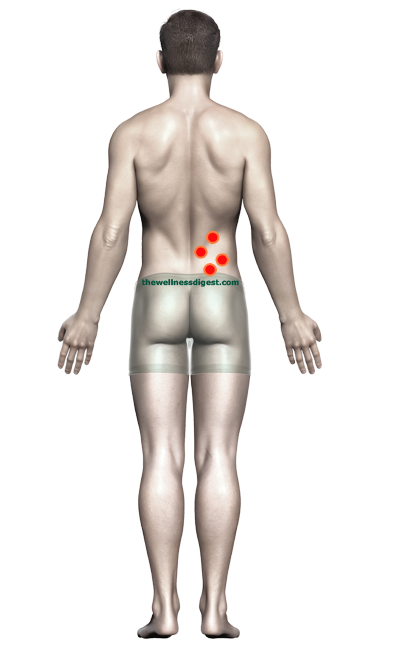
Trigger points are small, tender knots in the muscle that are caused by injury and stress. The knots are painful when pressed, and QL trigger points can send pain and tingling sensations into the buttocks, hips, lower abs, and thighs. You can use this diagram as a guide to find these painful knots.
Treatment
Trigger points resolve with pressure. Apply pressure to the area for 10-12 seconds and release. You need to apply enough pressure to feel uncomfortable, but not so much that pain is intolerable. Think of hurts so good, it hurts, but at the same time feels good. Repeat this 3 times per treatment. For the best results, apply three treatments daily: morning, afternoon, and evening. Continue treatments until pain and discomfort are gone.
Suggested Tools
For QL trigger point treatment, I recommend the Theracane. The candy cane shape makes it easy to use, and it provides precise pressure to trigger points. If you have mobility or balance issues, this is the tool to use as it can be used either standing or sitting and does not require balancing against a wall or getting down on the floor. The instruction manual, available online, is also included in the package.
If you are interested in learning about self-treating muscle pain and trigger points, The Trigger Point Workbook is an excellent resource to have on hand.
Recommended Pain-Relieving Gels
Pain-relieving gels can bring 4-6 hours of relief to painful muscles. Apply a small amount of the gel directly over painful areas. Do not massage during application, as this will uncomfortably intensify the heating/cooling effects. The gels can be reapplied every 4-6 hours.
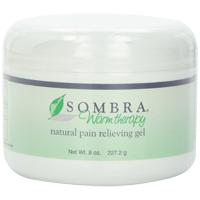 Sombra Warming Gel is recommended for chronic pain and mobility. Warms without excessive heat. (not sold in stores)
Sombra Warming Gel is recommended for chronic pain and mobility. Warms without excessive heat. (not sold in stores)
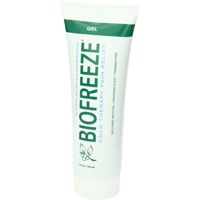 Biofreeze Professional Strength Pain Relieving Gel is recommended for injuries and repetitive use strains. The gel's cooling effect reduces inflammation and, in turn, relieves pain.
Biofreeze Professional Strength Pain Relieving Gel is recommended for injuries and repetitive use strains. The gel's cooling effect reduces inflammation and, in turn, relieves pain.
How Can You Prevent Quadratus Lumborum Pain?
-
- Strengthen your core muscles! Weak core muscles affect the entire body and are a primary contributor to low back pain.
- Evaluate your mattress. Does it provide support, or do you sink into it while sleeping? Sleeping on an overly soft bed contributes to back and other muscle pain throughout the body.
- Limit sitting time, get up, walk around, and stretch. If you have a desk job, consider investing in a standing desk to alternate standing and sitting through the day. Add a lumbar support to your chair to support the lower back.
- When lifting, use your legs for power. Don't rely on your back, shoulder, and arm muscles for strength.
- Never twist at the waist while lifting. Secure the item, then turn the body using your legs.
- Be aware of body mechanics and your conditioning level when playing sports. Golf, tennis, baseball, kayaking, and other activities that require hard twisting movements at the waist are problematic for the QL muscle.
- Horseback riding is good for strengthening back muscles overall. However, it is still sitting. Additionally, the QL muscle is working to stabilize and balance the upper body with the lower body, which can cause the muscles to be overworked. If you go for a long ride, get off periodically to walk. Your back and your horse will thank you!
Fun Facts About The Quadratus Lumborum
-
- The quadratus lumborum is often involved in lower back pain.
- Chronically tight QL muscles may lead to hip joint pain and dysfunction as well as sacroiliac joint dysfunction.
- It is known as the ‘hip hiker’ muscle because it raises the hip (think of how you raise your hip to balance a child you are carrying).
- It is a key stabilizer of the lower spine and plays an important role in maintaining posture and spinal alignment. It often compensates for weak core muscles which leads to overuse and pain.
- The quadratus lumborum muscle allows the separation of movement between the upper body and the lower body. Two examples are keeping the hips and legs still while moving and twisting the upper body and arms or moving the legs while keeping the upper body still.
- People who have one hip noticeably higher than the other are often experiencing problems with the quadratus lumborum.
It is not always the QL. Check which muscles might contribute to these conditions:
ABDOMINAL PAIN | ANKYLOSING SPONDYLITIS | BUTTOCK PAIN | GROIN PAIN | LOW BACK PAIN | PELVIC PAIN | QUADRATUS LUMBORUM SYNDROME | SCIATICA | STENOSIS | TROCHANTERIC BURSITIS | UPPER LEG PAIN
Muscle Groups
Abdominal, Low Back | Arm | Chest, Shoulder, Upper Back | Face, Head, Neck | Foot | Hand | Hip, Pelvis | Leg (Lower) | Leg (Upper) | Spine
Areas of Pain
Abdominal Pain | Ankle Pain | Arm (Low) Pain | Arm (Upper) Pain | Back (Low) Pain | Back (Upper) Pain | Chest Pain | Elbow Pain | Foot Pain | Groin Pain | Hand Pain | Head Pain | Hip Pain | Knee Pain | Leg (Low) Pain | Leg (Upper) Pain | Neck Pain | Pelvic Pain | Shoulder Pain | Wrist Pain
If this information helped you, please share it so others can benefit.
References:
Clay, J. H., Allen, L., Pounds, D. (2015). Clay & Pounds' Basic Clinical Massage Therapy: Integrating Anatomy and Treatment (3rd ed.). Philadelphia, PA: Lippincott Williams & Wilkins
Davies, C,. Davies, A., (2013). The Trigger Point Therapy Workbook: Your Self-Treatmend Guide For Pain Relief (3rd ed.). Oakland, CA: New Harbinger Publications
Finando, D., Finando, S. , (2005). Trigger Point Therapy for Myofascial Pain: The Practice of Informed Touch (1st ed.) Rochester, VT: Healing Arts Press.
Muscolino, J., (2016) Kinesiology: The Skeletal System and Muscle Function (3rd ed.). Maryland Heights, Missouri: Mosby.
